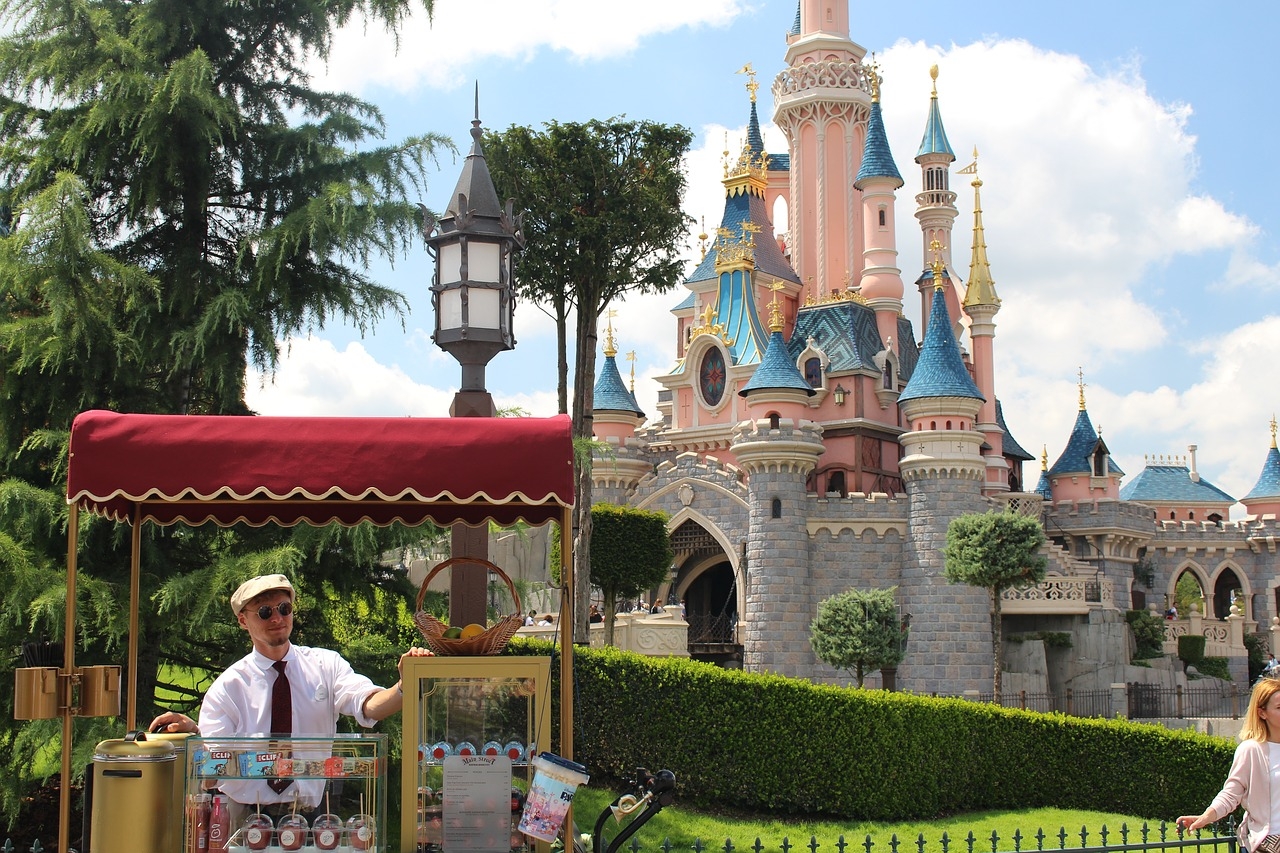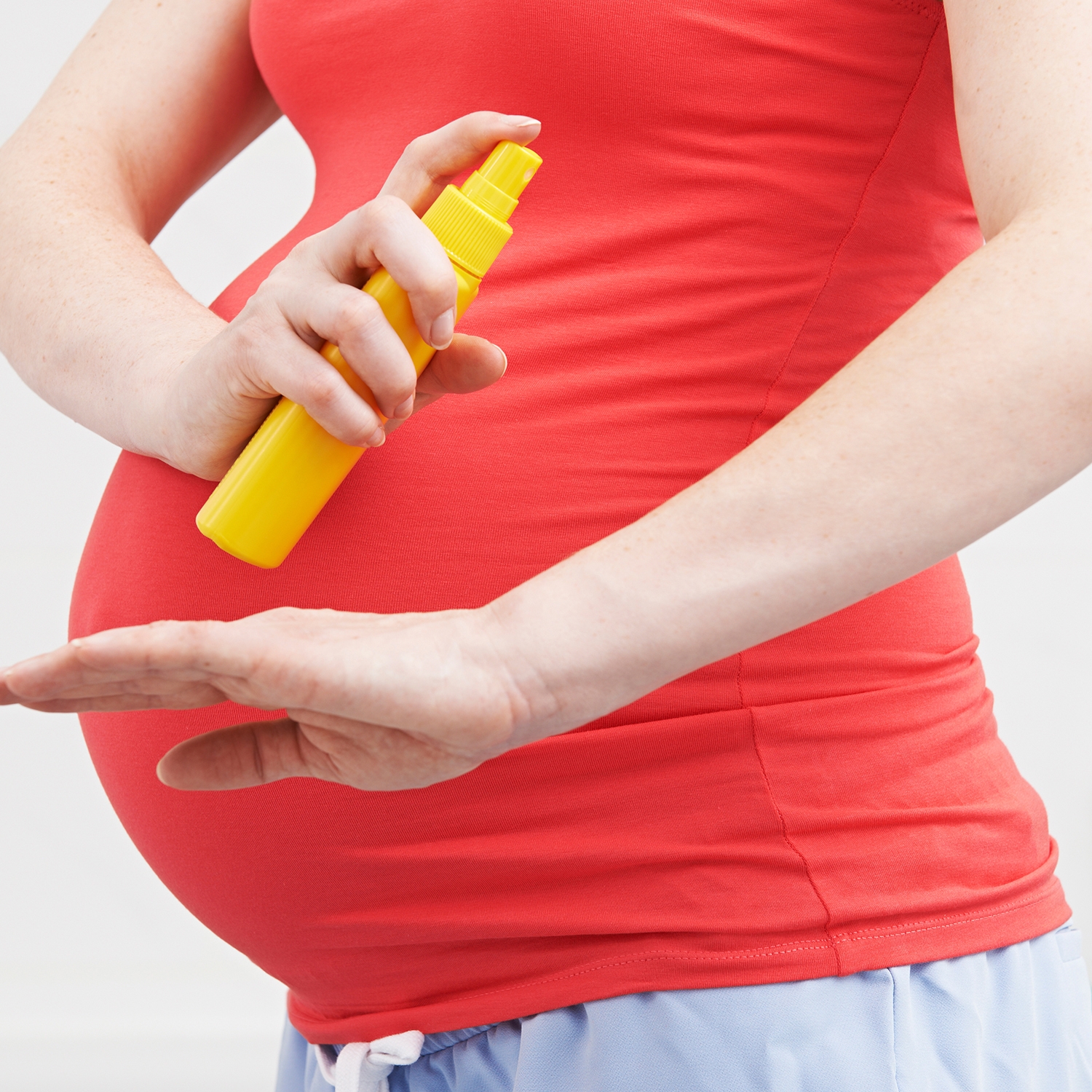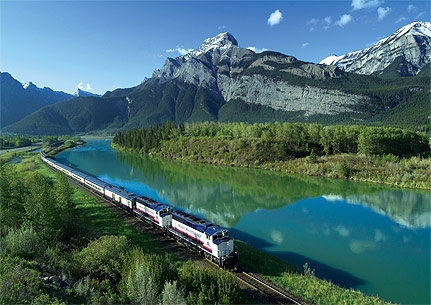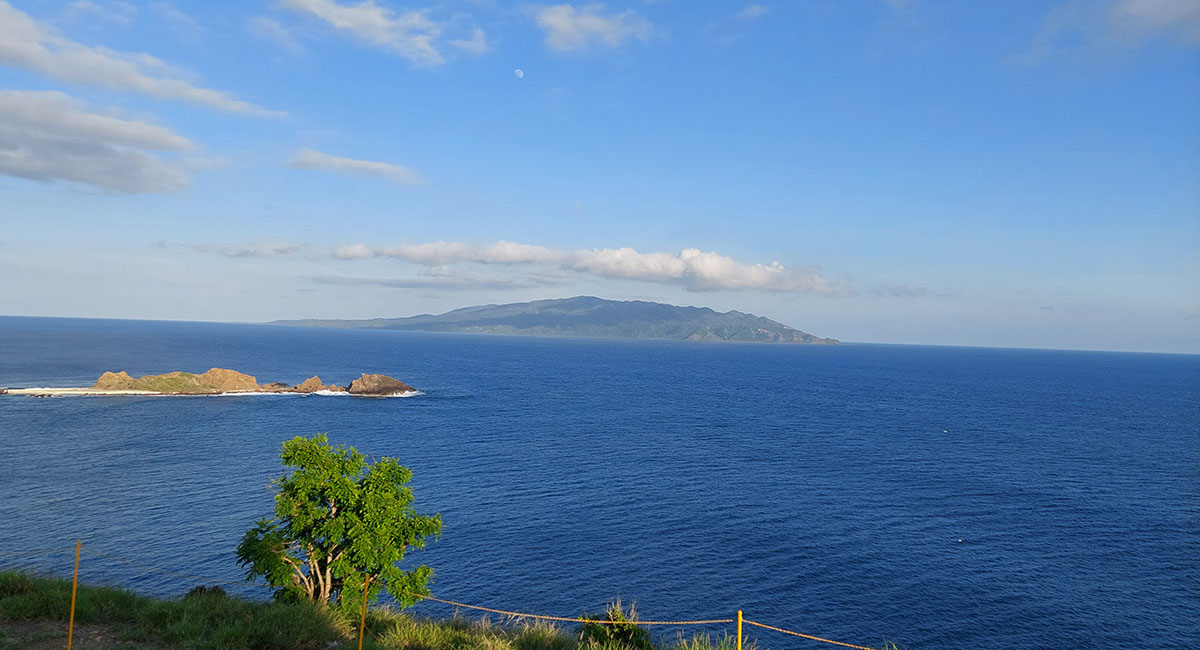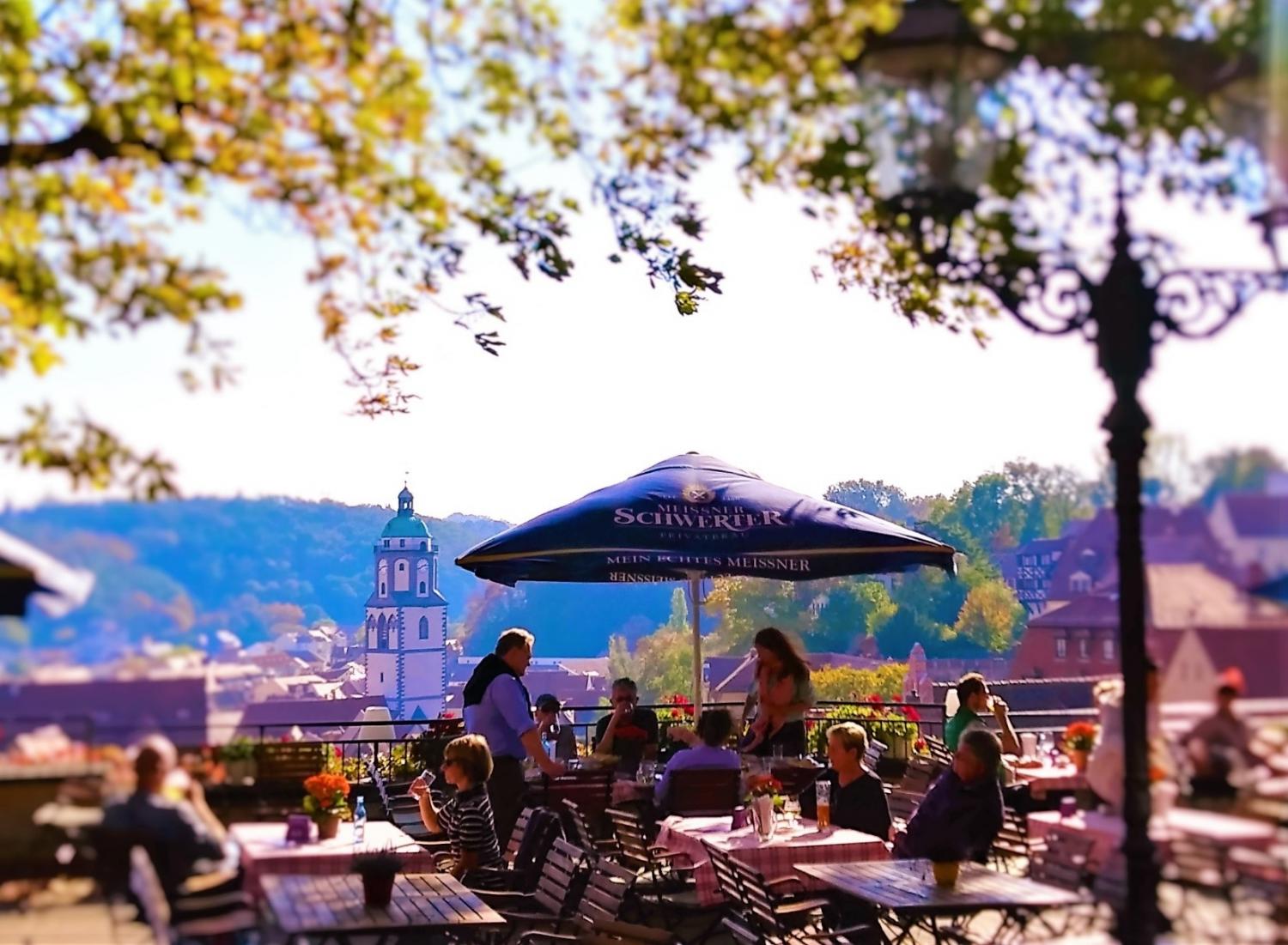
Fabulous Foods and World-Class Wines in Magical Saxony and Saxony Anhalt
Julia at the German tourism bureau tells me that Berlin is their number one destination for Canadian tourists. I get it. Just a short taxi ride through Berlin has me eager to return – for at least a week. The energy is high and the ubiquitous graffiti speaks of the rise of the artist's voice. But, for now, Berlin will have to wait – we are heading out of town in search of fabulous food and world-class wines.
The Cradle of Saxony – Meissen
A warm October sun stretches shadows across the meandering streets to the sound of our luggage rolling hard against the cobblestone. After a long journey, Meissen (Meißen) is a soft landing. A well-preserved medieval town situated on the Elbe River with Albrechtsburg Castle (15 C.) rising from the townscape and The Church of Our Lady's porcelain carillon ringing throughout the day, we have stepped back into history.
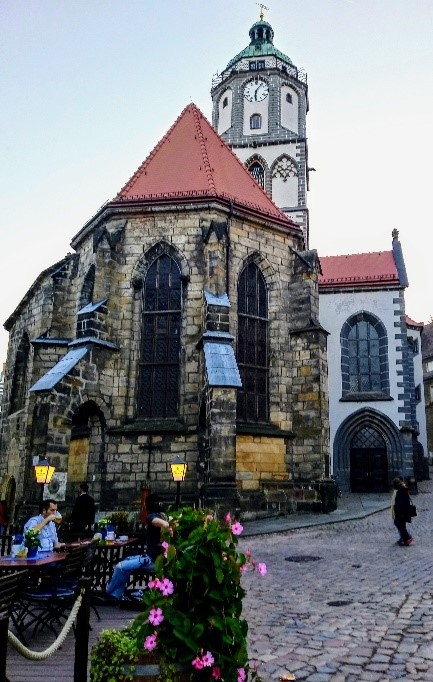 One of the oldest hotels in town, The Goldener Löwe Hotel, has come a long way since its days of featuring one “toiletten” to serve 38 beds in 20 unheated rooms! Now a nest of antique elegance intertwined with modern ingenuity, each room is uniquely styled – every bathroom is state of the art. A cascade of motion-sensored candelabras leads me down the centuries old stairwell to meet my dining-comrades.
One of the oldest hotels in town, The Goldener Löwe Hotel, has come a long way since its days of featuring one “toiletten” to serve 38 beds in 20 unheated rooms! Now a nest of antique elegance intertwined with modern ingenuity, each room is uniquely styled – every bathroom is state of the art. A cascade of motion-sensored candelabras leads me down the centuries old stairwell to meet my dining-comrades.
A white-on-white table setting is the backdrop for perfectly plated dishes: cold marinated carpaccios of veal, wild herb salad, homemade brioche, roasted corn chicken breast on stuffed hokkaido pumpkin, port wine jelly, thyme risotto, chocolate mousse, caramelized orange fillets and strawberry lime sorbet. Accompanied by a march of perfectly paired wines, the dining experience is entirely in sync with the hotel – the meal fuses bygone centuries with the new – a culinary fusion fit for a king. 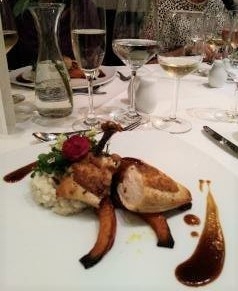
Germans are enjoying an early harvest after a hot and dry summer – and the wine is flowing plentiful. Of the thirteen “quality” wine regions in Germany, Saxony (Sachsen) has the smallest wine cultivation area (470 hectares). It is characterized by 800 years of wine production and is one of the most north-easterly in Europe. Since emancipation from Soviet occupation, the historic vineyards have been cultivated to produce world-class Saxonian wines and sparkling wines. Like elsewhere in Germany, white wines dominate production. Although domestic demand caused red wine production to surge in the 1990s and early 2000s – they now account for 20-30 per cent of German wine products. Spätburgunder, (Pinot Noir), is in the lead for red wine production.
Snuggled in the luxury of my room after a solo-romantic walk through slumbering Meissen, I reflect on why I have only every heard good things about travel in Germany. It's this – Germans have a handle on first-world problems, like no one else, as far as I can tell. Everything is organized, efficient and comfortable. You can count on your train arriving on time; that the hotel is as good as it looks on the website; that the washrooms will be squeaky clean; and that the service is uber competent! For me, a female who likes to wander uninhibited – day and night – Germany is one of the safest countries to explore, fearlessly. It all adds up to ease in travel – allowing one to enjoy all that Germany has to offer, which is a lot…
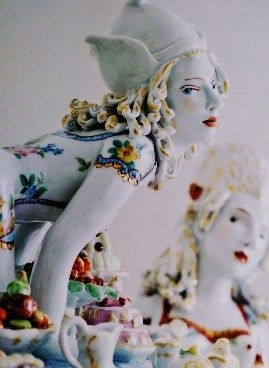 Meißen Porzellan Manufaktur
Meißen Porzellan Manufaktur
We start the new day with a unique visit – the first porcelain manufacturer in Europe – Meißen Porzellan Manufaktur. With an ever-growing archive of prototypes and artifacts (currently 700,000 moulds and 10,000 colour formations!), the factory incorporated the museum into its structure in 1916. Saxonia, Saxon's own “Statue of Liberty” and the world's largest free-standing porcelain figure, greets us at the entrance.
The guided tour includes live demonstrations by the factory's working artisans, as we journey from the early interest in Asian imports to the establishment of the factory by the illustrious Augustus the Strong in 1710, to the return of the factory to “Free Saxony” in 1991. The superbly curated collection displays the evolution of the original red porcelain to its culmination as the sleek white modern tableware, on which breakfast, lunch and afternoon tea are served in the museum's restaurant. Fascinating on so many levels, the visit was entirely enjoyable.
Weingut Schloss Proschwitz
Winding our way to our next stop, Weingut Schloss Proschwitz (a.k.a. "The Prince's Place”), our very knowledgeable chauffeur, Mr. Briessen, tells us in his thick German Accent, “I really like the Prince…he does a lot for the people…and he has a very good Christmas Market." According to Mr. Briessen, "after the political change” the Prince consulted his father about buying back the family palace, which the Prince did, but not without some finagling and a lot of patience as the estate slowly let go of its incarnation as a boy’s club. Since reestablishing ownership of the estate, the Prince's goal has been to make excellent, world-class wines. As the oldest private winery of Saxony (80 hectares), it is one of two Saxon members of the Association of German Prädikat Wine Estates (VDP), which recognizes the actual vineyard as the hallmark of excellence.
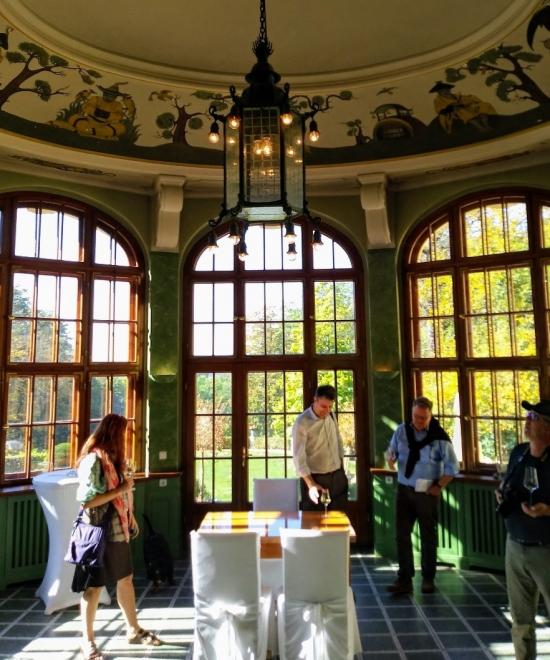
Clearly this is one down-to-earth Prince. Dr. Georg Prinz zur Lippe and his family live in the former servants' quarters, behind which there is a wooden fort on stilts (reportedly built by the Prince for his children). The palace is now used as an events venue. The setting, however, remains the stuff of fairy-tales, with great blue dome of sky above, red roses at my finger-tips and vineyards rolling out to the spires of Meissen in the distance. I do feel like a princess, savouring this perfectly balanced salmon-tinted Pinot Rosé that sparkles in my glass under the warmth of the midday sun.
We sip on a parade of superb wines, chatting, laughing and listening to the Vineyard Director, Walther, expound on all things grapes. The first, and most widely grown grape variety in Saxony is the Elbling grape. Brought here by the Romans, its re-cultivation is owed to the Prince. The cool climate and the range in temperature from day to night is an advantage – creating a special acidity in the wines, which is the hallmark of quality wines from this region.
This marks the beginning of a new-found appreciation for the great wines that are produced in this region of Germany. Riesling wines may be Germany's best export – but the quality wines that Germans are enjoying at home are well worth the visit! Alas, our Prince was occupied today. After such a charmed visit, we were sorry to miss him – a true Prince, he left each of us a fine bottle of one of his most iconic wines, Scheurebe Trocken (2017).
We return to town to say farewell from the bird's eye view of Meissen, the terrace of the Romantik Hotel Burgkellar (& Residenz Kerstinhaus), where we eat generous portions of locally sourced traditional foods and delicious German beer. Next stop Naumburg!
Naumburg, Saxony-Anhalt
Another soft landing at the Zur Alten Schmiede Hotel. The hotel's entrance and reception are old world elegance. My room, in the new addition, is modern-minimalist comfort. The hotel is perfectly situated to walk around the medieval town of Naumburg. With 1,000 years of history, there are many historic sites to see – notably, The Naumburg Cathedral, located on the medieval highway that connected East Europe to West Europe, it was designated a World Cultural Site in 2018. I could have spent an entire day in the cool air contained by the massive stone walls, exploring the architecture and the artwork that spans centuries.
Saale-Unstrut
Naumburg is the perfect launch from which to explore the Saale-Unstrut quality wine-growing region. So-named because it is situated on various hill slopes between the rivers Saale and Unstrut, it was formerly a part of East Germany. The most common (75 per cent) grape varieties are white. Varieties such as Müller-Thurgau and Silvaner, which elsewhere are considered to produce wines of more mediocre quality, produce better wines in the cold climate of the Saale-Unstrut region. The wines are labeled "varietally", as are most German wines. As elsewhere in this part of Germany, the wines are generally vinified dry with a refreshing acidity.
The drive through the Saale-Unstrut region can only be described as visual poetry with its untouched landscapes, castles ruins, cathedrals, monasteries, old bridges and sloping vineyard terraces – and, this journey can be made by train or bike! 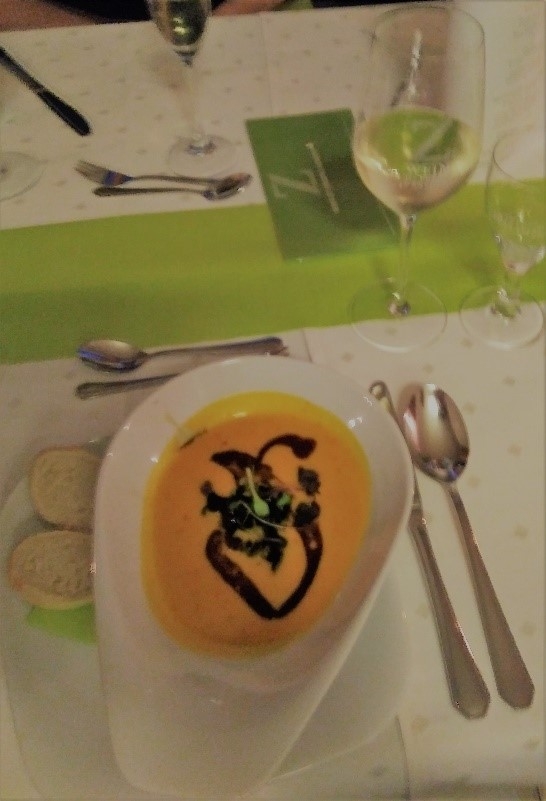
Weingut Zahn
At the end of the ever-narrowing road in the town of Großheringen, we arrive at the gates of Weingut Zahn. Located on the banks of The Saale River, the wooden gates open onto a cobble-stone terrace. Rural and elegant, this place is nothing if not romantic. A family-owned estate and member of the Breitengrad 51 wine cooperative, the restaurant, Thüringer Weinstube, is a popular spot with the locals due to its fabulous, food, wine and specialty events.
On offer are: picnics, crime fiction readings, hikes – even sunset yoga in the vineyards! The lavish feast of locally-sourced dishes unfolds before us. It's pumpkin season. With sixteen varieties to choose from, the meal opens with a sublimely delicious pumpkin soup. Followed by a heaping portion of catfish in a rich mushroom cream sauce; pear fritters with pistachio ice-cream for dessert and the enjoyment of great wines in great company – the entire dining experience was flawless.
Freyburg
Situated on the Unstrut River, with its terraced vineyards, historic town centre and superb 11th century castle, Freyburg has been aptly nick-named “The Tuscany of the North”. With more than a thousand years of wine growing history – the town annually hosts the September wine festival, known as “Winzerfest”. The high concentration of heat-retaining calcium is responsible for the significantly warmer micro-climate that supports grape-growing in this northerly region. Despite having only 700 hectares of vineyards under cultivation, there are several award-winning wine producers in the area – and it is the headquarters of one of the largest wine companies in the world – Rotkäppchen-Mumm.
Rotkäppchen-Mumm Sektkellereien GmbH
Sekt is the name for sparkling wines in Germany – and, they are not to be missed. The coolness of this northern region is perfect for producing grapes that don't fully ripen, have high acidity and less-developed flavours – which just happens to be the perfect recipe for effervescent wines. Without a doubt, the German pursuit of excellence applied to the “méthode champenoise” results in truly memorable sparkling wines.
A very colourful history has passed since two brothers and a friend first opened this winery in 1856. The name Rotkäppchen (Red Cap) was taken after the winery lost the battle to call their sparkling wines by French names. In 2017, 256.5 million bottles of wine, sparkling wines, spirits, and wine-based drinks were produced.
The winery prides itself on owning Germany's largest carved Cuvée vat with a capacity of 160,00 bottles! There are a range of tours and a myriad of festivals under the glass ceiling of the beautifully bricked “Courtyard of Light.” After a “guided” sampling and tour of sparkling wines, our appetites are stimulated and our spirits are high as we head off for lunch…
Weinberghotel Elelacker
The view from the spacious terrace at the Weinberghotel Elelacker is truly spectacular. The hotel partners with the Freyburg Wine Cooperative to pair wines with exquisite menus. Not a sound can be heard as everyone at the table is engrossed in savouring this delicious meal of elegantly plated dishes: terrine of goat's cheese, lobster bisque, tournedos of beef, and strawberry and white chocolate mousse. And, of course, a range of superb local wines – all amounting to dining perfection…
Weingut Herzer
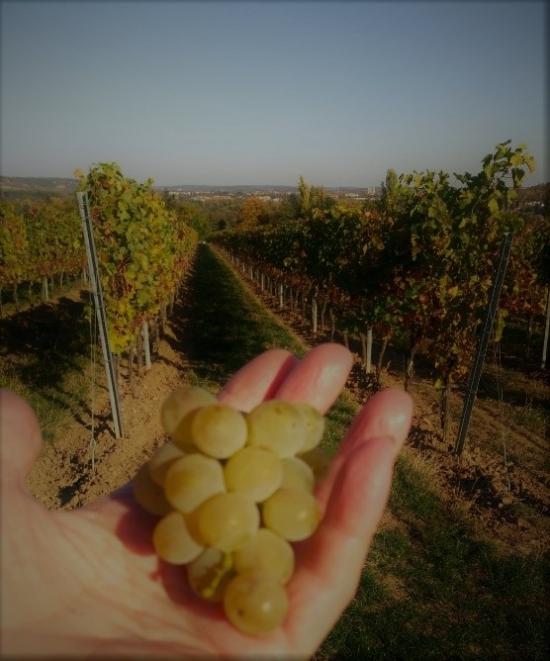 On a smaller scale (21 hectares), Weingut Herzer, is a family-owned winery that is full of heart. The owners, Andrea who has the great distinction of having been the second Wine Queen after 'the fall of the wall', and her husband, Stephen, a graduate of viticulture engineering and cellar management, live above the wine production area with their children.
On a smaller scale (21 hectares), Weingut Herzer, is a family-owned winery that is full of heart. The owners, Andrea who has the great distinction of having been the second Wine Queen after 'the fall of the wall', and her husband, Stephen, a graduate of viticulture engineering and cellar management, live above the wine production area with their children.
The vineyards feature yet another expansively beautiful view, which includes an old monastery where none other than Friedrich Neitsche once studied. The monastery is a reminder that, like elsewhere in Europe, the German Wine Industry owes much to The Church. At one time Christian monasteries controlled most of the major vineyards in Germany – not such a bad thing since The Church was responsible for putting quality before quantity. Only in the 1800s, when Napoleon took control of all the vineyards, were they secularized. As well, Napoleonic inheritance laws broke up the parcels of vineyards further – leading to the establishment of many cooperatives. It is only in modern times, and since emancipation from Soviet rule, that vineyards in this area have been able to produce wine for both domestic consumption and export.
Like elsewhere in this part of Germany, the Weingut Herzer vineyards are planted with 80 per cent white varieties and 20 per cent red varieties. As well, they produce sparkling wines and brandies. Our gregarious host, Stephen, provides us with a very colourful account of the trials, tribulations and – joy of producing and drinking wine. With a commitment to keeping things “green”, it is no small task to find ways to keep the birds, the raccoons and the wild boar from looting the vines!
With plenty of wine flowing in our veins from yet another Odyssey of quality wine-tasting, Stephen, quoting his father, expounds that, “One should always feel better the next day – for having drunk wine the night before.” After an entirely down-to-earth and charmed visit, it's nice to think that future generations will keep Weingut Herzer in business.
Dining in Naumburg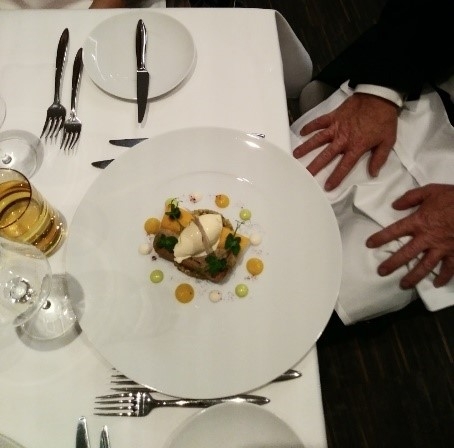
Just up the street from Naumburg Cathedral is the "Gasthof Zufriedenhelt". Pampered with white glove-service in an elegantly modern décor, another superb meal rolls out before us: low temperature cooked veal with potatoes, celery and cabbage and a chestnut mouse with Valrhona chocolate and two kinds of pear – and, of course, more great local wines!
Weinmanufaktur “Alte Zuckerfabrik” GmbH & Co. KG
Slow-paddling along the serenely beautiful Unstrut River (in a large dinghy!) on a sun-filled October morning can only be described as mythological – I was expecting nymphs to rise from the river. Our guide Chris, suggests that it is even better to make this journey by swimming – in the buff! And, our destination is no less magical…
Situated on the banks of the Unstrut River, the eponymously named Weinmanufaktur “Alte Zuckerfabrik” winery was founded (2013) on the site of an old sugar factory – and the first wines became award winners. The term “Weinmanufaktur” stands for the production of high-quality wines in limited quantities, which means that you must come here to enjoy these spectacular wines that will be consumed long before they can take the journey across the Atlantic!
This winery is all about a couple of inspired millennials doing things – exceptionally well. 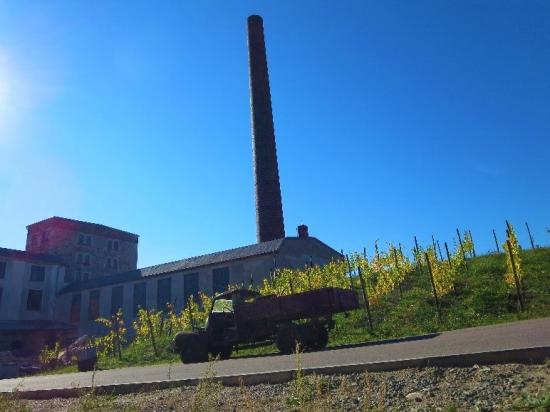 Chris (our dinghy captain) and his father purchased the factory. The wine production is scrupulously managed by Joyannes Beyer, “There are no big machines here – everything is done by hand. We hand pick the grapes – only the best are selected.” Grapes are also collected from local “hobby growers”. The wines are served at the Michelin-rated Falco Restaurant in Leipzig. Both the restaurant and the sparkling wines of Weinmanufaktur “Alte Zuckerfabrik” have been recognized in the German Culinary magazine Gault Millau.
Chris (our dinghy captain) and his father purchased the factory. The wine production is scrupulously managed by Joyannes Beyer, “There are no big machines here – everything is done by hand. We hand pick the grapes – only the best are selected.” Grapes are also collected from local “hobby growers”. The wines are served at the Michelin-rated Falco Restaurant in Leipzig. Both the restaurant and the sparkling wines of Weinmanufaktur “Alte Zuckerfabrik” have been recognized in the German Culinary magazine Gault Millau.
A modern spin is put on old traditions, as this dynamic team of entrepreneurs slowly and meticulously restore the factory, which includes a summer hostel. Visiting the restored cellars, we drink grapes in fermentation, straight from the barrels. This opaque, sweet, fruity amber drink is called Federweißer; and is traditionally served with onion cake (like a quiche).
The day just keeps getting better – Johannes pops open a bottle of – Weißburgunder Sekt! With the first sip – every step of the pureness of the growing, harvesting and production come through. A sparkling wine so perfect that each of us purchase a bottle to bring home. Followed by an open air traditional lunch by the river, I expect that the magic of this day will, like the finish on this superb Sekt, linger for a long time…
Schloss Wackerbarth
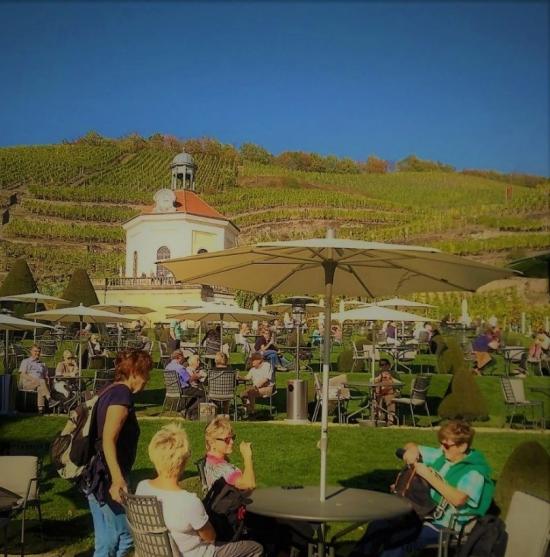 Located just outside the town of Radebeul, Schloss Wackerbarth is one of Europe's oldest sparkling wine producers (1836). Schloss is the German word for castle. “Schloss” on a wine label can also mean that the grapes are “estate-grown”. Another winery with a very long and colourful history, Augustus the Strong counts as one of the vineyards most prominent past customers.
Located just outside the town of Radebeul, Schloss Wackerbarth is one of Europe's oldest sparkling wine producers (1836). Schloss is the German word for castle. “Schloss” on a wine label can also mean that the grapes are “estate-grown”. Another winery with a very long and colourful history, Augustus the Strong counts as one of the vineyards most prominent past customers.
The steep vineyards of Schloss Wackerbarth are supported by beautiful stone walls that retain heat to create yet another suitable micro climate for growing grapes. Our guide reminds us that the massive cellars are not a museum – but a working production area where the cellar master turns each bottle by hand.
Schloss Wackerbarth boasts being the most important vineyard of the area with a hundred hectares – hosting 190,000 visitors a year! State-owned since 2002, it is an adventure-land in all things wine – with beautifully landscaped gardens, a baroque manor house, an award-winning restaurant, multiple tours, festivals, family events, a great gift shop and the option to hike the vineyards – there is something for everyone!
Before heading back to Radebeul to spend the night at the modern and luxurious Radisson Blu Park Hotel, it only makes sense to check out the nearby capital of Saxony…
Dresden
Berlin may be the number one destination for most Canadians, but I have always had a yen to visit the city of Dresden. With architecture on a 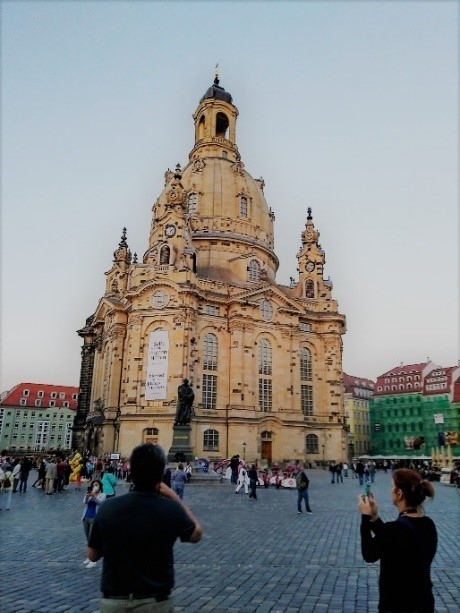 monumental building scale, Dresden has the same impact on the senses as Rome or Washington – the manifestation of Empire. The city center was completely destroyed by fire bombs on Feb 14th 1945. Dresden in the 21st Century is not so much about the monumental scale of the building as it is about the monumental scale of re-building!
monumental building scale, Dresden has the same impact on the senses as Rome or Washington – the manifestation of Empire. The city center was completely destroyed by fire bombs on Feb 14th 1945. Dresden in the 21st Century is not so much about the monumental scale of the building as it is about the monumental scale of re-building!
After a tour through the astoundingly opulent collection of The Green Vault, what better way to end this food and wine Odyssey than by checking out some beer samplers on the patio of Die Manufaktur Burgerie in Neumarkt Square. Our host, Jen, orders a large glass of beer, observing that this “beer sampling thing” is a new trend in Germany. Jen tells me that if I am looking for traditional German fare, the oldest Christmas Market in Germany is hosted right here in the city of Dresden. In 2019, the Dresden Striezelmarkt will be open for its 585th season – now, there's a compelling reason to return!
We head back to Radebul to eat generous portions of traditional food at the Sonnenhof at Altkötzschenbroda.
As with every other day on this journey, the morning began with a fabulous breakfast with an extensive choice – there is something for everyone – omnivore, vegetarian, vegan! And, plenty to get you through your day of sight-seeing until the supper hour. My personal favourite became the Bircher muesli. I have to agree with the travel blogger who described German breakfasts as – legendary!
Without a doubt, I would turn around and do this exact trip tomorrow. The food, the wine, the beauty, the adventure and the German pursuit of excellence made this the trip of a lifetime. Next up – I am heading out to discover a few of Germany’s many World Heritage Sites!

